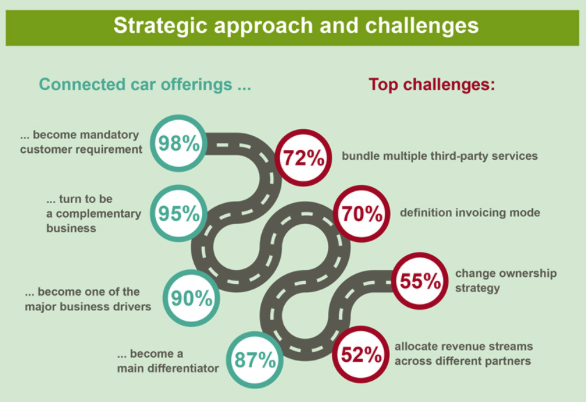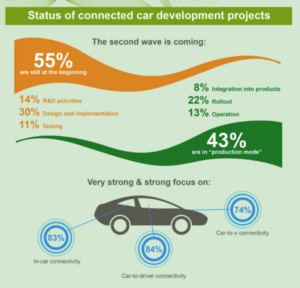The first generation (wave as PAC calls it) of connected car solutions, include infotainment and environmental information services, like weather traffic and road mapping updates. In the US, GM was an early pioneer of the connected car idea with its OnStar satellite service, in a collaboration with Electronic Data Systems, and Hughes Electronics Corp. in 1995. Service included remote geo-tracking and early day fleet management. PAC said in Europe, this is already rolled out and operated by manufacturers and services providers, and now expects a “…second generation of services, such as security, after-sales and driving assistance, currently being in development and testing phases”.
 Empowered by the rise of wireless technology and connected mobile devices, the connected car idea has expanded well beyond the early day’s of GM to encompass a much broader picture sometimes called the “Internet of Things.” This includes the linking of four major business areas with empowered connectivity in key areas of: mobility, industry, energy and home & buildings.
Empowered by the rise of wireless technology and connected mobile devices, the connected car idea has expanded well beyond the early day’s of GM to encompass a much broader picture sometimes called the “Internet of Things.” This includes the linking of four major business areas with empowered connectivity in key areas of: mobility, industry, energy and home & buildings.
In the auto space, the largest groups include the Connected Car Consortium with its 13 Charter members, (Nokia, Daimler, VW, Honda, Hyundai LG, Samsung, Toyota, GM, Alpine, HTC, Panasonic, PSA Automotive) with Core and Adopter members that make up the bulk of the auto, system integrator, electronic manufacturing and infotainment communities, worldwide. These companies have been working for years on the vision/development phase along with the collective vision of corporate pioneers in the space including Nokia, (the mapping division not sold to Microsoft) Bosch, (a major auto system integrator) Intel (with specific mobile chip initiatives) and many others.
For example, last year MirrorLink Solutions, a CCC member company developed its Mirror-link display that embeds an LCD into the rear view mirror to display images from behind the car while placed in reverse. One other iteration places the image from a camera embedded in the passenger rear view mirror displaying the blind spot on the CSD, whenever the right blinker is engaged. Both safety upgrades will save lives and reduce accidents.
One aspect of the Nokia Connected car vision includes its cloud-based car initiative meant to open up the embedded car systems to users, with the long term goal of bringing a familiar smartphone and tablet experience to the car dashboard. “Here Auto Cloud” and “Here Traffic” shown in 2013 at the Frankfurt Motor Show include maps and navigation, content for the car’s Center Stack Display (or CSD) system. Other embedded CSD features in the car, offer the same things available in a Windows 8 smartphone, 3D maps to real-time traffic, points of interest, street-level imaging and local business search.
Other In-Car connectivity solutions Nokia is working on include its “Here Auto Companion” with a suite of mobile “companion apps” that deliver the same apps in the car to the user’s smartphone and tablet. It connects the car telematics data including remote unlock, remote engines start and fuel/battery power gauges, even tire pressure. This can also extend to on-board music, all delivered to the smartphone mobile device.
As we continue to move forward, key issues of standardization, and consistent UI (from car to car) need to be addressed. And PAC also says the next technology wave will include “Car to Car” and “Car to X” connectivity that will go further still in the improvement of safety systems and even move us toward piloted vehicles. Look for more on this topic and the impact on the display market as we continue to track this future display direction. – Steve Sechrist

